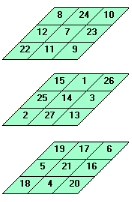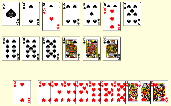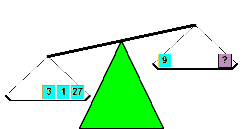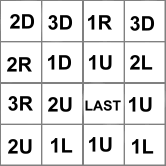Delphi For Fun Newsletter #28
[Home]
|
June 20, 2002: One of the proposed changes for the Traveling Salesman Program was implemented today. It was just too good to resist, reducing exhaustive search times for the 13 city closed route by 94% and increasing the maximum practical search size by a city or two. See the Further Explorations section at the bottom of the Traveling Salesman Program page for more details. |

 July 13,
2002: A Magic Cube is a logical extension of a magic
square into the third dimension. Here's a Magic Cube program that doesn't haven't have much user
interaction, but it does search, (and find), all 192
semi-perfect magic cubes of order 3. They are not quite
perfect because the diagonals on each face cannot be made
to sum to the required magic constant, 42. But the 31
rows, columns, pillars, and space diagonals (corner to
opposite corner through the center number) all can. By
the way, the smallest cube that can be perfect is
8x8x8. Beware! For a small percentage of the
population, playing with magic squares, cubes, and
hyper-cubes may be addictive!
July 13,
2002: A Magic Cube is a logical extension of a magic
square into the third dimension. Here's a Magic Cube program that doesn't haven't have much user
interaction, but it does search, (and find), all 192
semi-perfect magic cubes of order 3. They are not quite
perfect because the diagonals on each face cannot be made
to sum to the required magic constant, 42. But the 31
rows, columns, pillars, and space diagonals (corner to
opposite corner through the center number) all can. By
the way, the smallest cube that can be perfect is
8x8x8. Beware! For a small percentage of the
population, playing with magic squares, cubes, and
hyper-cubes may be addictive!
 July
15, 2002: Here's a
small puzzle that I've named
Solitaire for Squares. No chance involved here, just a little
thought and perseverance. Remove the Spades and Hearts
from a deck on cards. Layout the 13 Spades in order Ace
through King. Place a Heart on each Spade so that the sum
of each Spade-Heart pair is a perfect square (4, 9,16, or
25). Just to prove that it knows how, the program will
provide hints if you really get stuck.
July
15, 2002: Here's a
small puzzle that I've named
Solitaire for Squares. No chance involved here, just a little
thought and perseverance. Remove the Spades and Hearts
from a deck on cards. Layout the 13 Spades in order Ace
through King. Place a Heart on each Spade so that the sum
of each Spade-Heart pair is a perfect square (4, 9,16, or
25). Just to prove that it knows how, the program will
provide hints if you really get stuck.
 July 22, 2002:
Some kids wanted to set up a
lemonade stand to make money. To set themselves apart from
the other lemonade stands on the block, they decided to
sell their lemonade by the pound. They found an old
balance beam scale, the kind with a weight pan on each
side, and three weights. They discovered that they could
sell any whole number of pounds from 1 to 13. What weights
did they have.?
Weights #1 searches for the answer to this question
for any number of weights from 1 to 5. There's also a
scale where you can practice with things of unknown
weight, I guess they could be lemonade containers.
July 22, 2002:
Some kids wanted to set up a
lemonade stand to make money. To set themselves apart from
the other lemonade stands on the block, they decided to
sell their lemonade by the pound. They found an old
balance beam scale, the kind with a weight pan on each
side, and three weights. They discovered that they could
sell any whole number of pounds from 1 to 13. What weights
did they have.?
Weights #1 searches for the answer to this question
for any number of weights from 1 to 5. There's also a
scale where you can practice with things of unknown
weight, I guess they could be lemonade containers.
July 23, 2002: Today, I added a long needed Google "site search" feature to the left border of each page over in the Programs section. With more than 100 programs now (Google has indexed 300 pages), I'm having trouble locating things, and I put them there! Send me feedback if you have any problems.
 July 28, 2002: I've spent
most of this past week adding an explanation facility to
my "Logic Puzzle Solver" program. It solves most
of those logic puzzles found in Logic Puzzle magazines
from Dell Publications. It will take another week or so
of polishing, and we have the back-east grandkids
visiting next week, so I decided to post this beginner's
level T-Shirt program to fill the gap.
T-Shirt #5 helps us find the smallest 3 (or 4, 5, 6, 7,
8 or 9)-digit emirp for the front of our shirt.
July 28, 2002: I've spent
most of this past week adding an explanation facility to
my "Logic Puzzle Solver" program. It solves most
of those logic puzzles found in Logic Puzzle magazines
from Dell Publications. It will take another week or so
of polishing, and we have the back-east grandkids
visiting next week, so I decided to post this beginner's
level T-Shirt program to fill the gap.
T-Shirt #5 helps us find the smallest 3 (or 4, 5, 6, 7,
8 or 9)-digit emirp for the front of our shirt.
August 7, 2002: Well, it took 18 years, but here at last is the Logic Problem Solver program. Actually, I haven't been working on it for that long but I last compiled the original Turbo Pascal version in 1994. I converted it to Delphi and Windows and added the user interface a couple of years ago. This past month I finally worked up the courage to delve back in and make the 5000+ lines of code suitable for posting.
The program solves those: "Jeff has red hair. Kaitlin is 11. Who won the World Series?" type of logic word problems. There are three ways to play with the program: as a "Solver" you need to extract enough facts and rules from the included sample problems so that the program can figure out the solution. As an "Author" you can enter new problem descriptions. And finally, as a "Programmer" you can try to figure out how the heck it works (and perhaps make it work better).

August 10, 2002: Here's a program that solves "The Know-Don't Know Logic Problem", sometimes called "The Impossible Problem" or "The Sum-Product Problem".
Two integers, A and B, each between 2 and 100 inclusive, have been chosen. The product, A×B, is given to mathematician Dr. P. The sum, A+B, is given to mathematician Dr. S. They each know the range of numbers. Their conversation is as follows:
P: "I don't have the foggiest idea what your sum is, S."
S: "That's no news to me, P. I already knew that you didn't know. I don't know either."
P: "Aha, NOW I know what your sum must be, S!"
S: "And likewise P , I have figured out your product!!"What are the numbers?
It takes a little convoluted reasoning to solve it and most explanations left me slightly puzzled. My approach includes the best explanation you'll find (he said immodestly :>)).
August 16, 2002: An Oscilloscope program driven by sound card inputs has been on my list for quite a while. I finally bit the bullet and did it this week. Here's A Simple Oscilloscope program that is just that.

If you use a microphone for input and click your tongue and the "Stop Display" button at the same time, you can prove for yourself that there are really two distinct sounds generated - one when your tongue leaves the roof of your mouth and the other when it slaps the floor (of your mouth :>)).
____________________
Gary Darby
http://delphiforfun.org/
"Even the turtle never got anywhere without sticking his neck out" -- Unknown
|
|
|
|
|
 June 27, 2002: More
brain candy for the younger set. The
June 27, 2002: More
brain candy for the younger set. The